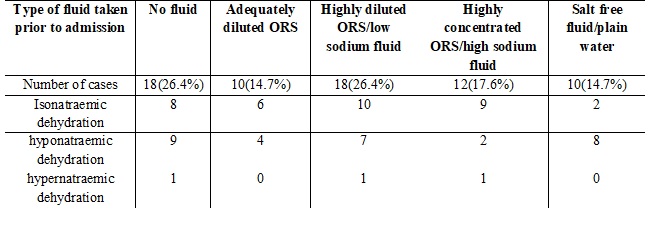A study on the types of dehydration and serum sodium level in infants and young children at the time of hospital admission with acute diarrhea in rural area of Jharkhand
Abstract
Objectives: This study was done to know the incidence of different type of dehydration clinically in acute watery diarrhea (mild, moderate and severe) along with serum sodium level (isonatraemic, hyponatraemic, hypernatraemic) at presentation in hospital.
Method: Prospective observational study done at admission on children below 5years of age with acute watery diarrhea. Dehydration was clinically classified as mild, moderate and severe. Serum sodium level was estimated at admission with Roche cobas autoanalyzer (indirect ISE method) and separated into 3 groups: (1) isonatraemic / hyponatraemic/ hypernatraemic dehydration. Children who had dysentery or diarrhea more than 7 days duration, taken iv fluids, metabolic disease/chronic medical condition were excluded from the study.
Results: There were 68 patients in which 64.7% were males.42.6% cases were between 1-2 year of age. 45 cases had moderate dehydration in which 57.7% had isonatraemic dehydration. 23 cases had severe dehydration in which 60.8% had hyponatraemic dehydration. There was no hypernatraemic dehydrated patients among severe dehydration / appropriate ORS or plain water groups. Only 10 (14.7%) cases were taking appropriate oral rehydration therapy in which 60% have isonatraemic dehydration.12 Patients on concentrated ORS had 75% isonatraemic dehydration. 18 Patients on diluted ORS had 55.5% isonatraemic dehydration.
Conclusion: About two third had moderate dehydration and majority had isonatraemic dehydration. Very few patients were given appropriate ORS therapy. Thus, we need to educate society about proper domiciliary treatment (appropriate fluid/ORS solution) in case of diarrhoea.
Downloads
References
2. Riddle MS, DuPont HL, Connor BA. ACG Clinical Guideline: Diagnosis, Treatment, and Prevention of Acute Diarrheal Infections in Adults. Am J Gastroenterol. 2016 May;111(5):602-22. doi: 10.1038/ajg.2016.126. Epub 2016 Apr 12.[pubmed]
3. Abdullah H Baqui,TahmeedAhmed,Diarrhoea and malnutrition in childrenReplacing fluid and minerals, particularly zinc, remains vitalBMJ. 2006 Feb 18; 332(7538): 378.doi:10.1136/bmj.332.7538.378
4. Million Death Study Collaborators, Bassani DG, Kumar R, et al. Causes of neonatal and child mortality in India: a nationally representative mortality survey. Lancet. 2010 Nov 27;376(9755):1853-60. doi: 10.1016/S0140-6736(10)61461-4. Epub 2010 Nov 12.
5. Kosek M, Bern C, Guerrant RL. The global burden of diarrhoeal disease, as estimated from studies published between 1992 and 2000. Bull World Health Organ. 2003;81(3):197-204. Epub 2003 May 16.[pubmed]
6. Bhan MK. Accelerated progress to reduce under-5 mortality in India. Lancet Glob Health. 2013 Oct;1(4):e172-3. doi: 10.1016/S2214-109X(13)70076-7. Epub 2013 Sep 19.[pubmed]
7. Jones G, Steketee RW, Black RE, et al. How many child deaths can we prevent this year? Lancet. 2003 Jul 5;362(9377):65-71. DOI:10.1016/S0140-6736(03)13811-1.[pubmed]
8. Karen S.Powers.Dehydration: Isonatremic, Hyponatremic, and Hypernatremic Recognition and Management.Pediatrics in Review Jul 2015, 36 (7) 274285; DOI: 10.1542/pir.36-7-274
9. Naruka BS, Sharma U, Saxena S. A clinical profile of diarrhoea in infancy and childhood. A study of 200 cases. Indian J Pediatr. 1974 Dec;41(323):374-83.[pubmed]
10. Mittal, S. K. ; Saxena, S. ; Mundkur, N. ; Srivastava, G. ; Gupta, S.Acute diarrhea inmalnourished children. Clinical, biochemical and bacteriological profile. Indian Pediatrics 1980; 17(3): 247-254.
11. DaralTS, Singh HP, Sachdev HP, Mohan M, Mathur M And Bhargava SK. acute dehydrating diarrhoea. clinical profile in neonates and young infants. Indianpediatrics. 1985; 22: 333-338.
12. Hirschhorn N. The treatment of acute diarrhea in children. An historical and physiological perspective. Am J Clin Nutr. 1980 Mar;33(3):637-63. DOI:10.1093/ajcn/33.3.637.[pubmed]
13. Kumar V, Datta N, Wadhwa SS, Singhi S. Morbidity and mortality in diarrhea in rural Haryana. Indian J Pediatr. 1985 Sep-Oct;52(418):455-61.[pubmed]
14. Bhargava SK, Sachdev HPS, DasGupta B et al. oral rehydration of neonates and young infants with dehydrating diarrhoea: comparison of low and standard sodium content in oral rehydration solutions. J. pediatr. gastroenterol nutr. 1984; 3:500-505.
15. Achar ST And Athreya BH. observations on some aspects of parenteral fluid therapy in infantile gastroenteritis in India. Indian pediatr. 1964; 1:309-318.
16. Ewe K., Karbach U. (1989) Functions of the Alimentary Canal. In: Schmidt R.F., Thews G. (eds) Human Physiology. Springer, Berlin, Heidelbergdoi.https://doi.org/10.1007/978-3-642-73831-9_29
17. Udani PM, Shah PM, Mukerji S, et al. Trends in the treatment of acute diarrhoeas in infancy. Indian Pediatr. 1968 Jan;5(1):1-16.[pubmed]
18. Kingston ME. Biochemical disturbances in breast-fed infants with gastroenteritis and dehydration. J Pediatr. 1973 Jun;82(6):1073-81.[pubmed]
19. Purohit KR, Jyotsna PS. Electrolyte disturbances in acute diarrhoea. Indian J Pediatr. 1971 Oct;38(285):393-5.[pubmed]
20. Aperia A, Marin L, Zetterström R, et al. Salt and water homeostasis during oral rehydration therapy. J Pediatr. 1983 Sep;103(3):364-9.[pubmed]
21. Herzog LW, Bithoney WG, Grand RJ. High sodium rehydration solutions in well-nourished outpatients. Acta Paediatr Scand. 1987 Mar;76(2):306-10.[pubmed]

Copyright (c) 2018 Author (s). Published by Siddharth Health Research and Social Welfare Society

This work is licensed under a Creative Commons Attribution 4.0 International License.


 OAI - Open Archives Initiative
OAI - Open Archives Initiative


